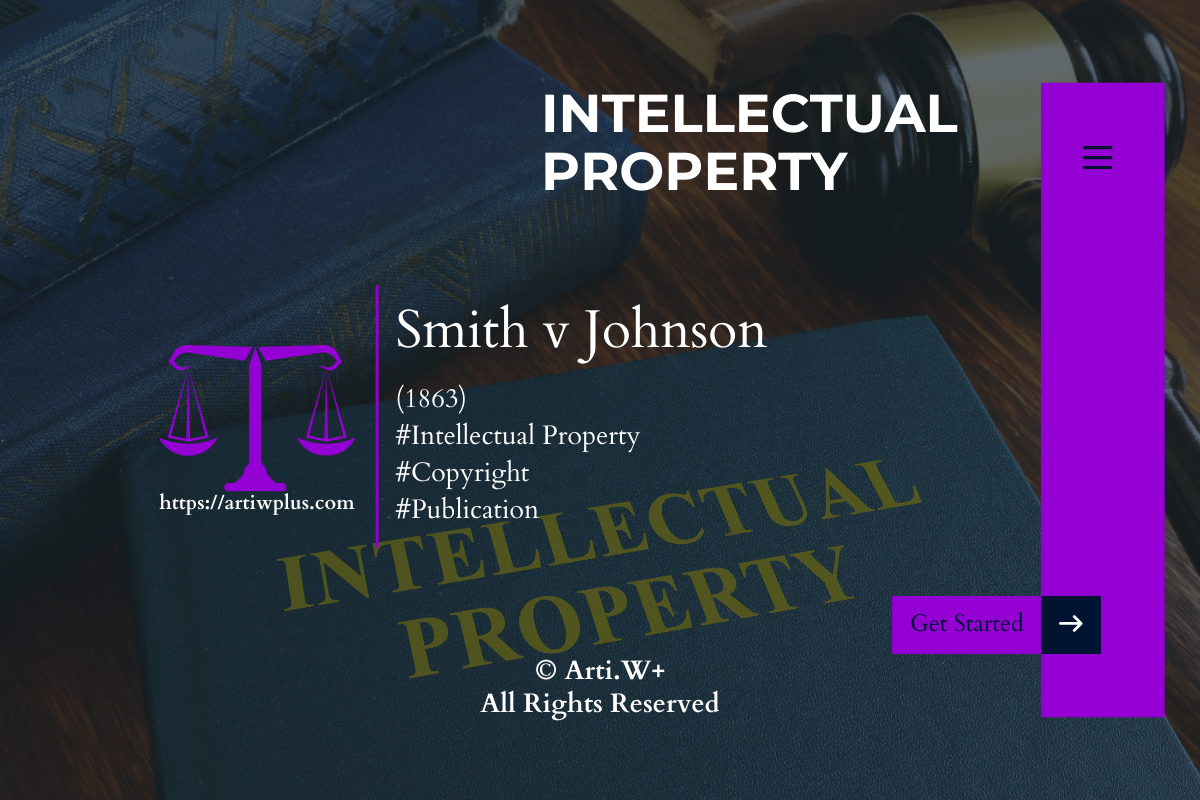📄 Case Summary ㅤㅤㅤㅤㅤㅤ
UK Law Case Summary
- Case Citation: Smith v Johnson [1863] 4 Giff 632, 66 ER 859
- Jurisdiction Tags: Intellectual Property, Copyright, and Publication
- Short Case Name: Smith v Johnson
- Court/Level: High Court of Chancery
Contents:
- Facts
- Issues
- Holding
- Rationale
- Rule/Principle Established
- Introduction
- Requirements
- Remedies
- Defences
- Information for Journalists
- Subsequent Applications
- Further Reading
- Cite This Summary
Facts
The plaintiff, Smith, was a writer who composed three tales for the London Journal, a weekly periodical owned by the defendant, Johnson. The tales were published in the London Journal in 1849, under the common title of “The Chronicles of Stanfield Hall”. Smith did not assign or relinquish any of his rights as an author to Johnson. In 1863, Johnson started to republish the tales in a supplementary number of the London Journal, which could be sold separately from the current number. Smith sued Johnson for infringing his copyright.
Issues
The main legal issues in the case were:
- Whether the publication of the tales in the supplementary number was a “publication separately” within the meaning of section 18 of the Copyright Act 1842.
- Whether Smith was entitled to an injunction to restrain Johnson from further publication of the tales.
Holding
The court held that the publication of the tales in the supplementary number was a “publication separately” within the meaning of section 18 of the Copyright Act 1842, and that Smith was entitled to an injunction to restrain Johnson from further publication of the tales.
Rationale
The court reasoned that the supplementary number was not merely a continuation of the London Journal, but a distinct publication that could be purchased independently.
The court also rejected Johnson’s argument that Smith had impliedly consented to the republication of the tales by not objecting to their previous publication in a monthly part of the London Journal.
The court found that there was no evidence of such consent, and that the monthly part was not a separate publication, but a mere convenience for the subscribers of the London Journal.
Rule/Principle Established
The case established that the publication of a work in a supplementary number of a periodical, which could be sold separately from the current number, was a “publication separately” within the meaning of section 18 of the Copyright Act 1842, and that the author of the work was entitled to an injunction to restrain such publication.
Introduction
The case relates to the legal concept of copyright, which is a form of intellectual property that grants the author of an original work the exclusive right to control its reproduction, distribution, and adaptation.
Requirements
The requirements for a valid copyright are:
- The work must be original, meaning that it is the result of the author’s own skill, labour, and judgment, and not copied from another source.
- The work must be fixed in a tangible medium of expression, such as a book, a painting, or a digital file.
- The work must fall within one of the categories of protected works, such as literary, artistic, musical, or dramatic works.
Remedies
The remedies for a copyright infringement are:
- An injunction, which is a court order that prohibits the infringer from continuing or repeating the infringing act.
- Damages, which are monetary compensation for the loss or injury suffered by the author as a result of the infringement.
- Account of profits, which is an order that requires the infringer to pay the author the profits made from the infringement.
- Delivery up or destruction, which is an order that requires the infringer to surrender or destroy the infringing copies of the work.
Defences
The defences for a copyright infringement are:
- Consent, which is a valid permission given by the author to the infringer to use the work in a certain way.
- Fair dealing, which is a limited exception that allows the use of the work for purposes such as research, private study, criticism, review, news reporting, parody, or education, provided that the use is fair and does not affect the normal exploitation of the work.
- Statutory licence, which is a legal authorization given by a statute to use the work in a specified manner, subject to certain conditions and payments.
- Expiry, which is the termination of the copyright protection after a certain period of time, usually the life of the author plus 70 years.
Information for Journalists
The case is relevant and important for journalists because it illustrates the scope and limits of the author’s rights over their works, and the potential consequences of infringing them.
The case also shows the distinction between different modes of publication, and the impact of such distinction on the author’s consent and the infringer’s liability.
The case highlights the need for journalists to respect the intellectual property of others, and to seek permission or rely on fair dealing when using their works
Subsequent Applications
The case has been cited and applied in subsequent cases involving the publication of works in periodicals or supplementary numbers, such as Aflalo v. Lawrence and Bullen, Limited, [1903] 1 Ch. 336; [1904] A. C. 17, where the House of Lords held that the publication of a novel in a weekly magazine, which could be bound together as a book, was a “publication separately” within the meaning of section 18 of the Copyright Act 1842.
Further Reading
- [Smith v Johnson - Case Law - VLEX 806168333]
- [CASE EXAMPLE SMITH V JOHNSON | Communication Law and Ethics]
- [The Smith v. Johnson Case: A Comprehensive Analysis of a Landmark Legal Battle - Medium]
Cite This Summary:
You can cite this summary using the following formats:
- APA: Copilot, M. (2024). Smith v Johnson - Case Summary. Retrieved from https://artiwplus.com/blog/cases/partridge-v-crittenden
- MLA: Copilot, Microsoft. “Smith v Johnson - Case Summary.” https://artiwplus.com/blog/cases/smith-v-johnson, 2024, https://artiwplus.com/blog/cases/smith-v-johnson.
- Chicago: Copilot, Microsoft. “Smith v Johnson - Case Summary.”https://artiwplus.com/blog/cases/smith-v-johnson, 2024, https://artiwplus.com/blog/cases/smith-v-johnson.

